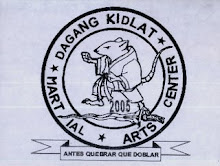Definition:
Offensive Mind-Set is thought through two processes: Neutral Offensive Linguistics and the physical modeling of offensive structure. We take people from fearful to fearless by using proactive linguistics to change thought patterns, and then anchor those thought patterns through physical action.
Neural Offensive Linguistics: The Power of Words
Neural Offensive Linguistics is the use of proactive terminology to replace fearful, defensive terminology. In a way, it's analogous to the glass is half full or empty' test for optimism or pessimism -- words have emotional weight to them, dependent on the situation in which we learned those words, and their associated ideas. The words we use to describe things affect the wayway we feel about those things -- for better or worse. If a word has a connection to a mental picture whose emotional content is fearful, then we must replace it with a fearless word in order to achieve an Offensive Mind-Set.
For example, if a person has been told to block a punch thrown at their face, they are immediately dropped into a fear-state. The very idea of blocking (which is linked in the mind to the word) is inherently defensive and based on fear -- the only reason a person would block the punch is because they are afraid of getting hit. Now, if we take the same person and instead tell them to strike the arm of an attacker throwing a punch, to cripple the arm, no fear-state is induced. In fact, we have done the opposite and induced a positive, take-charge attitude. This person has the source of their fear (the idea of blocking) replaced with a proactive, take-charge word (strike) with radically different connotations -- the fighter will injure the attacker. They will be incontrol of the situations, imposing their own will and strategy on the situation.
The use of Neural Offensive Linguistics is not restricted to combat training -- Offensive Mind-Set can be taught to anyone, for any purpose, to increase performance. The key is in isolating words associated with reactive thinking and replacing them with proactive word:
DEFENSIVE: OFFENSIVE:
Block Strike
Evade PenetrateDefender Fighter
Self-Defense Hostile ControlTry Do
Offensive Posture: First Strike
The new terminology is then reinforced through the modeling of offensive physical structure. If we take the above example and convert it from a thought problem to the real, physical world, we can anchor in the changes in the thought process. The person who has been told to block tries to block a real punch thrown at their face. Afraid or what might happen if they get hit, they move backward, away from the punch, and give ground to the attacker. The person fliches in indecision and throws up their arm to block, ducking their head and curving their spine to evade. By being driven back and modeling the fearful posture a deeper fear is induced, and failure is assured. Their fear has become a self-realized prophecy.
Now, the person is told to strike the arm -- to cripple the attacker. The attacker throws the punch at the fighter's face. In order to strike the arm, the fighter must step in, aggressively, with their spine straight and vertical to really hammer it. The attacker cries out in pain as he is jerked off balance and falls to the floor. The fighter sees success and will always remember how it felt (kinesthetically) to drop the attacker before them. The proactive thought has been realized as direct, potent action. We now have a demonstrable increase in performance.
Fear: The Shattered Foundation of Defense
The most basic, underlying concept of defense is fear. Whether it is defensive tactics, defensive techniques, for defensive thinking -- they are all based on fear. The very idea of 'self-defense' is fearful; you are more concerned with defending yourself than with taking out the attacker. You are worried about what the attacker will do to you, rather than what you will do to the attacker.
If you have been trained to block, you have been trained to fear the attacker. The idea of 'block' implies that you wait and see what the attacker throws at you, and then attempt to defend yourself by nullifying his attack. What does a block accomplish? It keeps you from getting hit -- maybe. But a block does nothing to change the situation in your favor; you have done nothing to take out the attacker. He is free to keep coming at you.
Even if you have been trained to 'block and strike' simultaneously, you are still operating fearfully. The defensive block and offensive strike work at cross-purposes -- they intefere with one another. The fear you feel at seeing the attacker move for you will cause you to hesitate, resulting in a strike that does not have 100 percent offensive commitment. Everyone has seen streetfights in which the participants hold their hands up in a defensive stance and feint toward each other, then jump back away from each other. They perform this strange dance repeatedly. Sometimes they lash out at each other, but always out of fear -- half-heartedly. This is because both of them are operating in a fear-state. They would really like to get the other guy, but they're just too afraid to commit to anything. They are preoccupied with defending themselves.


No comments:
Post a Comment